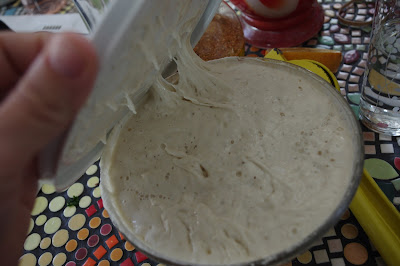Other notes I have are about flour and beer. I used Highland Gaelic Ale for this recipe, but I think it would be exceptionally good with a tasty porter or stout. If I can manage to not drink all of the Chocolate Stout from the local brewery. I might try that one next. As for flour, I have 6 kinds of wheat flour in my house at the moment. I have not experimented baking this recipe with all of them, but I do think half of what is good about this bread is the locally grown and milled Stone Ground Whole Wheat from a local farm. Freshly milled flour has a distinctive advantage in baking, as it still has the natural oils present and the texture and flavor is more complex. It does, however, have less gluten, so it's necessary to combine it with a white bread flour or straight vital wheat gluten if you want the loaf to hold together.
So here it is...my first successful sourdough bread recipe:
Ingredients:
1-2 cups sourdough starter (proofed, doubled and bubbly)
3 cups stone ground whole wheat flour (Sonrisa Farm Flour, if you are shopping locally)
2 cups unbleached, un-bromated white bread flour, plus extra for dusting the board while kneading
2 tsp kosher salt
1/4 cup canola oil
1/4 cup black strap molasses
About 2 cups of flat brown ale, porter or stout
Method:
The day before you want your fresh loaf of bread, wake-up your starter by feeding it some flour and water and leaving it on your kitchen counter (covered) for at least 8 hours, but preferably 12. Then before you go to bed, prepare the bread dough for the first rise. (Of course, if you are a night owl or like to bake at 3am, I suppose you could alter this schedule to suit your needs.)
Mix together the flours and salt in a large mixing bowl. Add the canola oil, molasses and 1-2 cups of sour dough starter. Gently begin to mix everything together with your hands or a wooden spoon while slowly adding 1 1/2 cups of the ale. When all of the flour has been folded into the dough, you can begin kneading. The dough will be heavy and somewhat dense, but if it feels dry and cracks you can kneed in a little more ale until the dough feels flexible but not sticky.
Kneading a bread dough seems to be a matter of preference. I won't tell you how to knead your dough, because I've seen people make the same kinds of bread with completely different techniques. I don't know much, but it seems to me that if you stretch and press in your favorite way, and do that until the dough feels fairly elastic, it's going to turn out just fine. It takes me about 5-10 minutes of kneading to get this dough to a fairly even texture. I form it into a neat ball. Oil a large glass or ceramic bowl and place the ball of dough in the bowl, then flip it so that both sides have a coating of oil. Cover lightly with plastic and leave overnight.
The next day, when you wake up, the dough should be doubled in size, but leave it longer if it needs to grow a bit more. Oil two loaf pans with canola oil. Punch the dough down, divide it, and knead each loaf for about 5 minutes. Form each into an oval and place in the loaf pans for the second rise. Make cuts in the top of the loaves with a sharp knife and spray or brush the tops with oil.
Cover loosely with plastic and set in a draft-free part of your kitchen to rise. This may take 2-3 hours, but the dough should rise about 1/2 inch above the tops of your loaf pans when it's ready to bake. If you are using glass pans, you will also see larger bubbles forming in the dough.
Preheat oven to 375 degrees.
When the loaves are finished rising, remove the plastic and place in the center of the preheated oven. Set your timer for 40 minutes. Adjust time as needed, but the bread is ready when they are golden brown on top and have a hollow sound when tapped. Remove from pans immediately and place on a cooling rack. Slice when the loaves have completely cooled.


Chyela, you never cease to amaze me. can my mom buy a loaf to take home to my sour dough loving dad? he's Scottish and English. :-)
ReplyDeleteI would be delighted to make a loaf or two for your Mom & Dad. Just let me know when you need them.
ReplyDelete